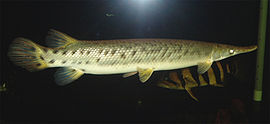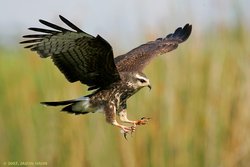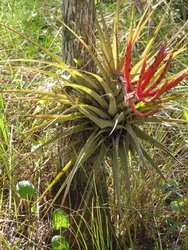Everglades flora and fauna
Contents
Introduction
The Everglades flora and fauna are characterized by a rich diversity of plants and animals. The Everglades ecosystem contains a unique and diverse array of habitats including mangrove swamp, pinelands, tropical hardwood hammocks, tree islands, freshwater marshes and coastal estuary. This diversity, along with its situation at the crossroads between the tropics and the temperate climate produce a significant amount of endemic speciesthat are extremely unique in their appearance and habits. This article is not intended to be an exhaustive account of the biodiversity of the Everglades, but seeks to highlight many of the salient features and the interesting and unique flora and fauna endemic to this ecosystem.
Due to the relative youngness of the southern Florida Peninsula as an emergent limestone karst plateau, the biodiversity and endemism within the Everglades is not considered high. Nevertheless, the fragility of the Everglades ecosystem must be viewed critically in light of the Deepwater Horizon oil spill and potential coastal impacts to endangered flora and fauna, even though most of the Everglades is a freshwater system; moreover, there is direct contact between the Everglades aquifers (Groundwater) and seawater intrusion from the Gulf of Mexico.
Invertebrates
Invertebrates in the Everglades form a very diverse faunal group, which has great importance due to the diversity of predators who consume these invertebrates; numerous wading birds, reptiles, fish, amphibians and other species are predators (Predator-prey cycles) depend on Everglades invertebrates for their existence.
The Florida applesnail is a fascinating freshwater mollusk found in the Everglades. This snail has a unique physiology in that it is capable of using its gills to extract oxygen from water, but also able to breathe in air using a lung equivalent. To accomplish air breathing, the snail emerges from water and climbs a plant stem to extend its tube-like siphon and suck air into its body cavity. Thus, the applesnail does not occur in open or deep water, since it is dependent on plant stems for emergence. Not only is the applesnail unique in its physiology, it is an extremely important member of the Everglades ecosystem. The snail kite, which is restricted to south Florida, is a raptor that feeds exclusively on applesnails. The limpkin, a wading bird also inhabiting only south Florida, likewise is extremely dependent on the applsnail for survival. Larvae applesnails are dependent on specific water levels in order to survive and reach adulthood. If the water is too deep, the larvae are submerged and die. If the water level is below the soil, the snails also die. Therefore, due to this specificity and its importance as a food source to birds, it is important for water managers to maintain the water at safe levels for snails to survive.
The Seminole rams-horn is a common snail of the Everglades and an important prey item of the redear sunfish, which is adapted to cracking open the shell and feeding on snails. Unlike the applesnail, the rams-horn is found in a wide variety of freshwater habitats. This is due to its ability to its ability to survive for long periods of time burrowed under moist soil. This species can also disperse relatively long distances by attaching itself to the water surface and taking advantage of wind currents propelling the water. Thus, the Seminole ram-horn can be found in permanently flooded open or vegetated habitats, as well as ephemeral wetlands.
The riverine grass shrimp and the side-swimmer amphipod are two abundant species in the Everglades and are so important to the ecosystem that they are considered keystone species. The grass shrimp, which are transparent and virtually invisible, are preyed on by almost every single predatory fish in the Everglades. Conversely, most wading birds do not eat the shrimp because of their small size and camouflage with the water. However, the shrimp are an important link in the food chain to fish-eating birds. The side-swimmer amphipod can be as abundant as 9000 individuals per square yard and are preyed upon by numerous aquatic invertebrates and small fish.
Fish
The Everglades is relatively poor in fish species diversity and endemism, with only thirty species of freshwater fish. Cyprinodontiforms represent the dominant group of fishes, but the standing stock of fish biomass is small compared to other coastal wetlands of North America. At least ten percent of the fishes in the Everglades are alien species.
The Florida Gar is native to the Everglades and is unique in appearance with its long snout and razor-like teeth. Gar are a type of living fossils, in that they have changed little from their ancestors, which came about during the dinosaur era of Mesozoic. They have a primitive overlapping pattern of their scales, which contrasts considerably from most other fishes. They also are unique in that they can breathe in air as well as water, using a sort of air pocket in their bladder to rise to surface to collect oxygen.
Amphibians
Amphibians in the Everglades are represented by relatively few species, as is the case of absence of species richness for many other faunal groups. This outcome is probably related to the fact that the southern part of Florida is a relatively young emergent karst limestone plateau. There is a paucity of salamanders and anurans in the far southerly reach of the Florida peninsula.
The Pig frog is common throughout the Everglades, akin to the bullfrog and economically important in the region of South Florida. Just as the bullfrog, they consume an astonishing amount of insects. They use their camouflage and have adapted to a sit and wait strategy to catch any prey moving that they can swallow. Pig frogs are commonly hunted in south Florida for their meat, but their abundance and importance in the Everglades ecosystem remains high despite of this.
Reptiles
There are fifty indigenous reptilian species within the Everglades; besides the iconic American alligator, there are 27 snake species and 16 species of turtles present here. Some of these species are common to other wetlands of the Deep South of the USA.
The Florida redbelly turtle is perhaps the most common turtle in the Everglades and has a fascinating lifestyle in its relationship with the American Alligator. This relationship is a rare example of a true commensalism in which the turtle benefits and the alligator is unaffected. The shell of the Florida redbelly is harder than most other turtles, making this species almost invulnerable to predation from gators. The reproductive strategy of the female redbelly is to lay its eggs in an alligator nest during the day when the gator is absent. The eggs are protected at night from the female alligator and then instinctively protected as if they were her own babies once they hatch.
The American alligator is a vital part of the Everglades ecosystem and a keystone species. Alligators build ponds by uprooting soil and vegetation around the edge of a preexisting wetland depression. This action expands the depression and creates an alligator hole. These alligator holes are particularly important during the dry season of the Everglades from November until May. The holes are refuges for many frogs, water snakes, fish, and turtles. These immigrants to the alligator holes access them by means of the alligator trails and reproduce in the holes to provide a large population when water levels rise during the wet months. These aquatic animals are also important food for wading birds, which flock to the alligator holes during the dry period.
Birds
The situation of birds in the Everglades is at a critical juncture, especially regarding endangered bird species within the Everglades. Action on water quality protection is particularly vital. According to the 2008 report of the National Research Council: Progress toward restoring the Everglades, some of the threatened bird species may be close to entering an extinction vortex (e.g. a point where the inevitability of extinction is assured); thus the importance of following through with restoration plans is vital. These factors may be particularly critical, since coastal impacts from the Deepwater Horizon oil spill are likely to impact parts of south Florida.
The wood stork is a unique and fascinating wading bird that is fairly common in the Everglades. It presents a contrast in feeding strategy to birds such as herons and egrets (also common in the Everglades) in that it does not rely on sight to catch its prey. It drags a partially open beak through muddy water, using highly sensitive receptors to detect any moving fish. It additionally uses its feet to stir up fish and can snap its jaws together in 0.03 seconds to snag a fish.
While it can outcompete herons and egrets in muddied water, it is an inferior fisherman to these birds in clear water where a sight dependent feeding strategy is optimal. The wood stork is dependent on shallow pools of water in which fish and other crustaceans are concentrated. Because of this very specific habitat requirement it is endangered in the United States and water levels must be managed in accordance with the breeding cycle of the wood stork, which can be as long as 150 days and is the longest of any of Florida’s wading birds.
The roseate spoonbill is a fairly common bird in the Everglades and also uses a unique feeding strategy. It uses its spoon-shaped bill to make side-to-side sweeping motions to catch fish. It also commonly uses a cooperative feeding strategy when several birds form a line to assist in catching fish. The brilliant pink color of the spoonbills is derived from extracting a red pigment of crustaceans in their diet.
The only place in the United States that avid birders can see a Snail kite is the Everglades region of Florida. The snail kite is dark brown in females or black in males with a white-tipped tail and comparable in size to a Red-shouldered hawk. The kite uses its hooked bill to grab applesnails from the water, which is nearly is sole source of food. The snail kite is so totally dependent on the applesnails that water levels must be managed in accordance with the life cycle of the snail. Shallow marshes with scattered, but not dense, vegetation are optimal so that the snails are visible to hunt when they are perched on vegetation slightly below the surface of the water. Snail kites sometimes relocate considerable distances throughout their range in south Florida when local habitat is not optimal.
The Cape Sable seaside sparrow is a subspecies of seaside sparrow entirely restricted in range to the Everglades and Big Cypress Preserve. This is the most restricted range of any North American bird. The bird is highly dependent on marl prairie habitat and fire to maintain muhly grass habitat and prevent succession of shrubs. However, fire also prevents the bird from nesting and using this habitat for one year following a burn until the grass grows back to suitable length to allow nesting. Furthermore, flooding of greater than about 4 inches inhibits nesting success. The subspecies of this bird, because it is so restricted in range and so specialized, has been reduced in numbers to the hundreds and is highly threatened with extinction.
Mammals
There are a number of small mammals, some aquatic mammals and one large apex predator representing mammals in the Everglades. The tree islands of the Everglades represent an unusual amount of biodiversity, given the small size of many of these islands. The Cotton rat and Prairie vole are inhabitants of some of these islands, which offer rich vegetative understory and protection from predators.
The Florida panther is an endangered subspecies of the puma or cougar. The cat is mostly restricted to southern Florida and its population reached 80 individuals in 2002. The home range of male panthers is about 250 miles, while female panthers have a range of less than 100 miles. The panther preys mostly on deer and feral hogs, but will also eat medium or small mammals. In 1995, eight Texas cougars were introduced to southern Florida in an attempt to bolster the low genetic diversity of the remaining panthers. There have also been efforts to better understand panther movement patterns and requirements through radio tracking. Efforts have been made to preserve movement corridor through implementing highway underpasses to minimize road fatalities.
Flora
Plant enthusiasts or the even the casual ecotourist would find the astonishing biodiversity of plant life in the Everglades to be an inviting paradise. Interestingly, most of the flora occurring in the Everglades and south of Lake Okeechobee are not temperate plants and have tropical or subtropical affiliations. A little over 60 percent of the 1650 plant species present south of Lake Okeechobee are affiliated with the tropics, while only 40 percent of the plants are temperate species. Of the 1650 total plant species, there is significant endemism of nine percent. Found only in South Florida and nowhere else in the world, these species have a distant mixed temperate and tropical origin. Realizing that most of the botanical diversity in the tropical rainforests is woody, rather than herbaceous, one would expect a large proportion of the woody plants in the Everglades to have tropical origins. This is indeed the case, with 77 percent of the woody species being tropical. It is interesting to note how drastically and quickly the vegetation changes as one moves northward from the Everglades region. The Pigeon-plum and West Indian mahogany, which are common tropical hammock species in the Everglades, switch to rare status as one merely travels only as far north as Fort Lauderdale.
Those making the trek to the Everglades can witness the occurrence of two tropical freshwater wetland trees that are interestingly also found in tropical West Africa and tropical America, the Pond apple and Cocoplum. Of the impressive palm tree species diversity of eight that occur in southern Florida, four of these occur in the Everglades. The Everglades boasts an impressive diversity of epiphytic plants, mostly ferns, orchids, and bromeliads. In fact, sixty species of ferns inhabit southern Florida. Ferns occupy a variety of habitats and are prevalent in dense shady conditions, unlike most bromeliads and orchids, which need more sunlight. Fifteen species of bromeliads occur in Florida with most of these occurring in south Florida. The beautiful showcase bromeliad of the Everglades is the cardinal airplant, which has showy red bracts and leaves that can exceed three feet in length. Most of the Everglades orchids originated from wind dispersed seeds in the West Indies, and 60 species are shared with Cuba.
References and further reading
- Russell S. Harmon, Carol M. Wicks, Derek C. Ford and William Blaine White. 2006. Perspectives on karst geomorphology, hydrology and geochemistry. 366 pages
- Thomas E. Lodge. 2005. The Everglades Handbook. Understanding the Ecosystem. CRC Press. Boca Raton, FL. ISBN 1-5667-0614-9
- James Watson Porter and Karen G. Porter. 2002. The Everglades, Florida Bay and Coral Reefs in the Florida Keys. CRC Press. 1000 pages
- William Edward Duellman. 1999. Patterns of distribution of amphibians: a global perspective. JHU Press. 633 pages
- Fred Hal Sklar and Arnoud van der Valk. 2002. Tree islands of the Everglades. Springer. 541 page
- Edward R. Ricciuti. 1997. Natural History of North America. 224 pages







